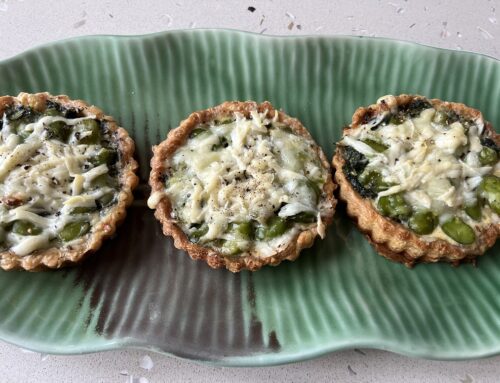Both Pâte Brissé and Pâte Sucrée are short cut pastry; Pâte Brissé is the same as Pâte Sucrée but without the sugar.
Ingredients:
200g flour
100g cold, unsalted butter, cut into pieces
1 egg yolk
½ tsp salt, omit if using salted butter
3 tbsp, 45ml, ice cold water – or more if necessary
Method:
If making the pastry by hand: sift the flour onto a work surface and make a well in the centre. Put the egg yolk, salt, and water in the well. Pound the butter with a rolling pin to soften it, add it to the well, and work the ingredients in the well with the fingers of one hand until thoroughly mixed.
Using a pastry scraper, gradually draw in the flour from the sides of the well and continue working with both hands until coarse crumbs form. If the crumbs seem dry, sprinkle with another tablespoon of water; the crumbs should be soft but not sticky. Gently press the crumbs into a ball; the dough will be uneven and unblended at this point.
If making with the food processor: blend the flour and butter in food processor until crumbly. Break the egg into a small container, add the water and mix with a fork. Add it down the funnel and process until mixture just begins to creep up the sides of the food processor. Turn out onto a very lightly floured work surface.
Continue here for both methods:
‘Fraiser’ the dough – blend the dough with heel of hand, gently pushing small amounts away from you with a scaping motion.
With the heel of your hand, push the dough away from you, flattening it against the work surface. Gather it up, press it into a rough ball, and flatten it again. This flattening motion evenly blends the butter with the other ingredients without overworking the dough. Work quickly so the butter doesn’t get too warm.
Gather it up with a pastry scraper and continue to knead, gently. Repeat this 3 or 4 times, for a minute or two. The dough will be as smooth as putty and will peel easily away from the work surface in one piece.
Shape it into a ball, wrap, and chill until firm, 15 to 30 minutes. Pâte brisée may be refrigerated, tightly wrapped, for up to 2 days, or frozen for up to 3 months.
On a lightly floured work surface, roll out dough, working quickly so it does not soften too much Keep the dough moving loosely on the board as you roll it so it does not stick.
It is a good idea to roll the dough in between 2 sheets of cling film to roll it as this makes it easy to handle and move around. You do not want to add too much extra flour, as that will alter the proportions of the dough.
Or, alternatively, dust bench with flour tossing across bench sideways. Lightly wipe flour onto rolling pin.
Roll from the centre out turning to ensure pastry is not sticking. Do not roll the pin over the edge of the pastry.
Roll until the pastry is about 2 -3 mm, or the thickness of a gold coin. Roll the dough over the rolling pin; unroll it carefully over the tin; press into tin paying close attention to the corners. Use a small piece of dough dipped in flour to push dough into corners. Press the dough up the sides of the tin to increase the height of the rim.
Prick, or dock, the bottom with a fork or pastry docker to release the steam and prevent air bubbles forming during the baking. Chill for 15 – 30 minutes, until firm. Remove from the fridge and prepare for the blind baking.
To blind bake the pastry: cover the pastry with some baking paper, to line the tin and fill with weights. Bake until the edges are golden. Remove weights and paper; return to oven and bake uncovered for 10 minutes or so, to brown sides and base. Cold pastry cases may be used now or sealed well and frozen for months.
Add images






